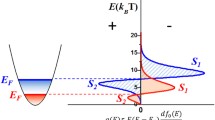Abstract
We examine the effective properties of a thermoelectric material in the vicinity of an arbitrarily shaped hole. Using complex variable methods, we establish closed-form representations of the electric and thermal fields in the matrix surrounding the hole. Specifically, we analyze the effective material parameters of a rectangular thermoelectric region containing an insulated macroscopic hole and determine that the effective electric and thermal conductivities depend strongly on the size and shape of the hole while the effective Seebeck coefficient always remains equal to that of the surrounding matrix. Perhaps most significantly, we conclude that since an insulated hole has almost the same effect on both the effective electric and thermal conductivities, its introduction does not affect the effective thermoelectric figure of merit in most thermoelectric materials. Consequently, we can conclude that, for the most part, an arbitrarily shaped hole can be inserted into a thermoelectric material without decreasing its maximum thermoelectric conversion efficiency. Our findings provide an important theoretical basis for the future design and development of thermoelectric devices.






Similar content being viewed by others
References
Chein, R., Huang, G.: Thermoelectric cooler application in electronic cooling. Appl. Therm. Eng. 24, 2207–2217 (2004)
He, W., Zhang, G., Zhang, X., Ji, J., Li, G., Zhao, X.: Recent development and application of thermoelectric generator and cooler. Appl. Energy 143, 1–25 (2015)
Liu, X., Deng, Y.D., Li, Z., Su, C.Q.: Performance analysis of a waste heat recovery thermoelectric generation system for automotive application. Energy Convers. Manag. 90, 121–127 (2015)
Venkatasubramanian, R., Siivola, E., Colpitts, T., O’quinn, B.: Thin-film thermoelectric devices with high room-temperature figures of merit. Nature 413, 597 (2001)
Shi, X., Chen, L.: Thermoelectric materials step up. Nat. Mater. 15, 691 (2016)
Tritt, T.M., Böttner, H., Chen, L.: Thermoelectrics: direct solar thermal energy conversion. MRS Bull. 33, 366–368 (2008)
Sevinçli, H., Cuniberti, G.: Enhanced thermoelectric figure of merit in edge-disordered zigzag graphene nanoribbons. Phys. Rev. B 81, 113401 (2010)
Kim, G.H., Shao, L., Zhang, K., Pipe, K.P.: Engineered doping of organic semiconductors for enhanced thermoelectric efficiency. Nat. Mater. 12, 719 (2013)
Perumal, S., Roychowdhury, S., Biswas, K.: Reduction of thermal conductivity through nanostructuring enhances the thermoelectric figure of merit in Ge\(_{1-x}\)Bi\(_x\)Te. Inorg. Chem. Front. 3, 125–132 (2016)
Fu, C., Wu, H., Liu, Y., He, J., Zhao, X., Zhu, T.: Enhancing the figure of merit of heavy-band thermoelectric materials through hierarchical phonon scattering. Adv. Sci. 3, 1600035 (2016)
Galli, G., Donadio, D.: Thermoelectric materials: silicon stops heat in its tracks. Nat. Nanotechnol. 5, 701 (2010)
Pramanick, A.K., Das, P.K.: Constructal design of a thermoelectric device. Int. J. Heat Mass Transf. 49, 1420–1429 (2006)
Yang, Y., Ma, F.Y., Lei, C.H., Liu, Y.Y., Li, J.Y.: Is thermoelectric conversion efficiency of a composite bounded by its constituents? Appl. Phys. Lett. 102, 053905 (2013)
Snyder, G.J., Ursell, T.S.: Thermoelectric efficiency and compatibility. Phys. Rev. Lett. 91, 148301 (2003)
Yang, Y., Gao, C., Li, J.: The effective thermoelectric properties of core–shell composites. Acta Mech. 225, 1211–1222 (2014)
Zhang, A.B., Wang, B.L., Wang, J., Du, J.K., Xie, C.: Effect of cracking on the thermoelectric conversion efficiency of thermoelectric materials. J. Appl. Phys. 121, 045105 (2017)
Wang, P., Wang, K.F., Wang, B.L., Cui, Y.J.: Effective thermoelectric conversion properties of thermoelectric composites containing a crack/hole. Compos. Struct. 191, 180–189 (2018)
Callen, H.B.: Thermodynamics: An Introduction to the Physical Theories of Equilibrium Thermostatics and Irreversible Thermodynamics. Wiley, New York (1960)
Milton, G.W.: The Theory of Composites. Cambridge University Press, Cambridge (2002)
Song, K., Song, H.P., Gao, C.F.: Unavoidable electric current caused by inhomogeneities and its influence on measured material parameters of thermoelectric materials. J. Appl. Phys. 123, 124105 (2018)
Muskhelishvili, N.I.: Some Basic Problems of Mathematical Theory of Elasticity. Noordhoff, Leyden (1975)
Song, H.P., Song, K., Gao, C.F.: Temperature and thermal stress around an elliptic functional defect in a thermoelectric material. Mech. Mater. 130, 58–64 (2019)
Yang, Y., Xie, S.H., Ma, F.Y., Li, J.Y.: On the effective thermoelectric properties of layered heterogeneous medium. J. Appl. Phys. 111, 013510 (2012)
Song, K., Song, H.P., Li, M., Schiavone, P., Gao, C.F.: Effective properties of a thermoelectric composite containing an elliptic inhomogeneity. Int. J. Heat Mass Transf. 135, 1319–1326 (2019)
Wang, S., Dai, M., Ru, C.Q., Gao, C.F.: Stress field around an arbitrarily shaped nanosized hole with surface tension. Acta Mech. 225, 3453–3462 (2014)
Acknowledgements
The authors are indebted to two anonymous reviewers whose comments and suggestions have improved the paper significantly. K. Song appreciates the support of the China Scholarship Council. H.P. Song and Gao acknowledge the support of the National Natural Science Foundation of China (Grant Nos. 11872203 and 11202099), the Priority Academic Program Development of Jiangsu Higher Education Institutions (PAPD). Schiavone thanks the Natural Sciences and Engineering Research Council of Canada for their support through a Discovery Grant (Grant # RGPIN 155112).
Author information
Authors and Affiliations
Corresponding authors
Additional information
Publisher's Note
Springer Nature remains neutral with regard to jurisdictional claims in published maps and institutional affiliations.
Rights and permissions
About this article
Cite this article
Song, K., Song, HP., Schiavone, P. et al. The influence of an arbitrarily shaped hole on the effective properties of a thermoelectric material. Acta Mech 230, 3693–3702 (2019). https://doi.org/10.1007/s00707-019-02468-x
Received:
Revised:
Published:
Issue Date:
DOI: https://doi.org/10.1007/s00707-019-02468-x




